ArtReview sent a questionnaire to artists and curators exhibiting in and curating the various national pavilions of the 2024 Venice Biennale, the responses to which will be published daily in the leadup to and during the Venice Biennale, which runs from 20 April – 24 November.
Maria Madeira is representing Timor-Leste; the pavilion is presented at Spazio Ravà.

ArtReview What do you think of when you think of Venice?
Maria Madeira I think of gondolas, water canals and of course the Biennale.
AR What can you tell us about your exhibition plans for Venice?
MM Mine is a site specific installation work entitled Kiss and Don’t Tell, to be exhibited at the Spazio Ravà. I will also carry out a few performances during the opening as part of the installation.
AR Why is the Venice Biennale still important, if at all? And what is the importance of showing there? Is it about visibility, inclusion, acknowledgement?
MM Venice Biennale is still important because: it gives opportunities for visual artists to showcase their artistic expressions at the highest international level; it facilitates and encourages crosscultutal dialogue thus reinforcing cultural awareness and understanding; and it gives opportunity for the general public to experience and engage with contemporary visual arts and cultural discourse.
For me the importance of showing there is monumental. This is the first time there will be a Timor-Leste Pavilion at the Venice Biennale and I will be the first artist to represent the country. I say: it is a small step for me but a big leap for Timor-Leste’s contemporary arts discourse.
And of course this step includes visibility not just for me but for all other East Timorese contemporary visual artists. And inclusion and acknowledgement, because finally the world gets to see that Timor-Leste also has a contemporary visual arts culture.
AR When you make artworks do you have a specific audience in mind?
MM I consider myself an artist of tradition whereby my artworks often merge the traditional with the contemporary; the past and the present. My core objective as an artist, researcher and arts advisor has always been to go beyond a love of change, and always with traditions in mind. Additionally, the amalgamation of the traditional with the contemporary in this case reinforces my view that by merging the old with the new a new language will be created, one that is understood not only by the East Timorese but also from the Western perspective. So when I create I often think about how the people of Timor-Leste vs the international community will respond to the artwork.
AR Do you think there is such a thing as national art? Or is all art universal? Is there something that defines your nation’s artistic traditions? And what is misunderstood or forgotten about your nation’s art history?
MM I consider that there is both a ‘national art’ and a ‘universal art’. For instance, I believe there is such a thing as national art especially with nations that are still heavily embedded within their traditional roots.
On the other hand I also understand that art is a universal language. Regardless of whether it is traditional or contemporary, culturally specific or mainstream, it is still a creative expression that can be seen and experienced by all.
AR If someone were to visit your nation, what three things would you recommend they see or read in order to understand it better?
MM Read about the traditional cultural societies in Timor-Leste; when travelling around the country avoid taking too much luggage and make sure you have mosquito repellent and drinking water; East Timorese people are very approachable, so don’t hesitate to ask for help when needed.
AR Which other artists have influenced or inspired you?
MM Jackson Pollock, Degas, Picasso.
AR What, other than your own work, are you looking forward to seeing while you are in Venice?
MM I look forward to seeing and interacting with all other artists to discuss artistic journeys and perspectives. In particular, I look forward to meeting artists that work with indigenous and traditional elements because I would love to learn and explore more about it with other diverse cultures.
The 60th Venice Biennale, 20 April – 24 November

